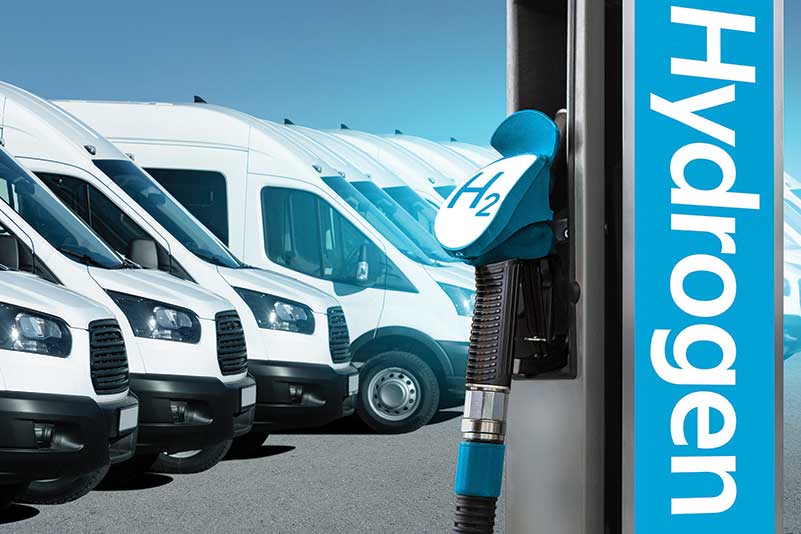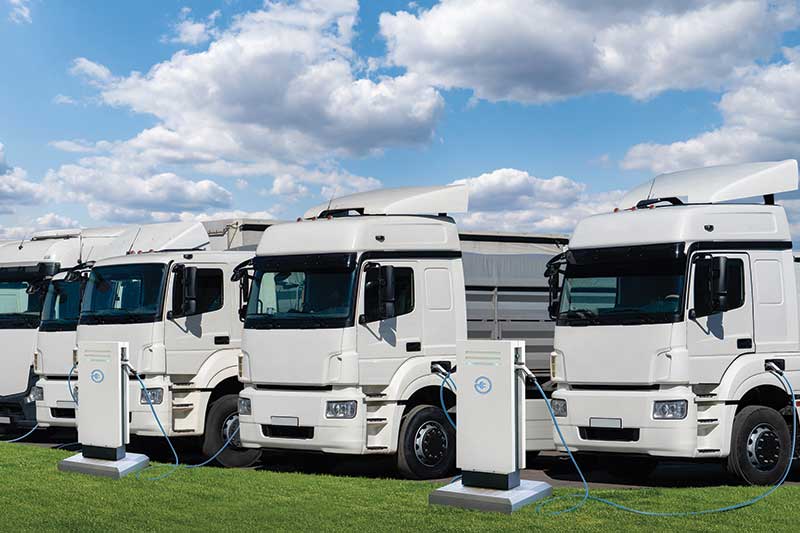2023 Regulations Update: Alternative fuel and speed take center stage
If shippers think implications from pending truck regulation issues don’t affect them, they’d be wrong. Most of these proposed regs around alternative fuels and speed have a direct impact on truck capacity and costs—and eventually rates.
Trucking, though economically deregulated at the state and federal levels, remains an industry facing an array of rules and regulations covering everything including safety; fuel and engine standards; speed of trucks; drug testing of drivers; and even parking spots.
But today, the overwhelming concern for truck fleets and top carrier executives is which technology—if any—will replace the diesel engine, which has been the workhorse of the trucking industry for the past century.
When asked what’s the most nagging regulation facing truckers, Werner Enterprises chairman, president and CEO Derek Leathers quickly responded: “The avalanche of mandates for the electrification of heavy-duty trucking.”
In Germany, home of Rudolph Diesel, engineers are favoring hydrogen trucks for long-distance road transport. In fact, more hydrogen-powered trucks are taking to the road in Europe every week, and energy firms in Germany are joining up for the sea-to-inland hydrogen route to power heavy trucks in the region.
But here in the United States, hydrogen-powered trucks seem decades away from taking the place of the diesel engine. Battery-powered trucks also have their hindrances, namely the extreme weight of the batteries necessary. And then there’s the sketchy supply chain of minerals—mostly from Africa and China—needed to make heavy duty batteries for commercial trucks.
Besides alternatively-fueled vehicles, there are regulations in the pipeline that would limit speeds of heavy trucks that would have ramifications for drivers’ income—which is typically based on number of miles driven. Fewer miles means less pay.
Shippers may think implications from these truck regulation issues don’t affect them, but they’d be wrong. Most of these proposed regs have a direct impact on truck capacity and costs—and eventually rates. Let’s take an extended look at which regulations are most likely to affect shippers the hardest.

It’s electrifying
Last June, President Joe Biden vetoed a resolution that passed in the U.S House and Senate that would have nullified the Environmental Protection Agency’s (EPA) Heavy-Duty Truck Rule, which was announced in December and took effect in March.
That rule tightens emission limits for nitrogen oxide (NOx) from commercial trucks beginning with the 2027 model year. It limits tailpipe NOx limits to a level 80%-plus below the current standard and reducing the particulate matter limit by 50%.
In vetoing the bill, Biden said that the EPA’s rule “cuts pollution, boosts public health, and advances environmental justice in communities across the country. It will prevent hundreds, if not thousands, of premature deaths, thousands of childhood asthma cases, and millions of missed school days every year.”
Democrats and environmentalists say that the tighter emissions rules provide $36 billion in benefits to society. “An opportunity to lead on the defining crisis of our time,” the President said.
However, it’s going to be a tough sell to trucking executives to reduce dependence on diesels in the trucking industry. For starters, the technology is good, reliable and the energy density and power production capability do not have a peer. Most trucking CEOs say that they want all options on the table—not just batteries. But mostly, they say that the deadline for conversion away from diesel is too aggressive and not realistic.
“Werner wants partners in state government who recognize taking the internal combustion engine off roadways by 2040 or 2045 could have ramifications on fragile supply chains, not to mention the electric grid,” says Leathers, adding that his company takes pride in reducing emissions from diesel particulate matter, carbon dioxide and other known pollutants, while running the cleanest technology on the market.
In short, Leathers is recommending a careful transition to electric—along with hydrogen, compressed natural gas and other energy sources—as long as the utilities and infrastructure allow. Batteries are currently limited by chemistry and materials.
Hydrogen has potential, but it will have some big issues on cost. Since it’s not an energy source, the cost of production is high and it’s difficult to store—and dangerous. Hydrogen also greatly shortens the life of engines. Fuel cells are great, but still need platinum, a very expensive metal.
However, politicians are proceeding apace. Last November, President Biden signed an international agreement placing the U.S. alongside other countries requiring heavy truck manufacturers to sell nothing but medium- and heavy-duty zero-emission vehicles (ZEVs) by 2040.
The Global Memorandum of Understanding on Zero-Emission Medium-and Heavy-Duty Vehicles predicts that sales of new, medium-duty ZEVs will comprise 30% of sales by 2030. EVs are now twice the price of diesel-powered trucks, and once you tack on the cost of infrastructure, driver and technician training as well as new shop equipment, it’s over $300,000 each. Without massive cash incentives from the government, trucking leaders say that it will be quite difficult to afford these vehicles.
However, major original equipment manufacturers (OEMs) are under no illusions that fleets will receive generous incentives like those found in California if there’s a shift to electric trucks. Right now, e-truck sales are minuscule.
Production at Nikola, a Phoenix-based e-truck manufacturer, fell to 33 units in this year’s second quarter. First-quarter production was 63. By comparison, sales of traditional diesel-powered trucks in this country were just a shade less than 300,000 for the 12 months ended July 1, according to FTR, a leading trucking advisory firm.
Bottom Line: Look for California’s Hybrid and Zero-Emission Truck and Bus Voucher Incentive Project (HVIP) to be adopted by other states. HVIP currently provides funding for 152 Class 3 to Class 8 vehicles, most of which are all-electric. But lacking heavy government financial incentives, e-truck sales are likely to remain only in California.
California made global headlines in April when it became the first government in the world to mandate the end of sales of conventional internal combustion trucks by 2036. Fleets wishing to continue to do business at the nation’s busiest ports and elsewhere in the Golden State will have until 2045 to make the switch to zero-emission trucks, which currently includes all-electric and fuel-cell. Other states could follow.
In April, the Biden administration proposed the toughest U.S. emissions regulations yet by moving model year 2032 medium-duty EV sales up to 46% of the segment share and light-duty EV sales to 67%.
Speed limiters are coming
Electronically activated speed limiters are another pending issue before heavy fleets. On this, the industry—or at least that part of it represented by the American Trucking Associations (ATA)—has done a flip-flop.
At the ATA convention in Las Vegas in 2016, president and CEO Chris Spear blasted a federal proposal to require speed limiters in trucks. “Proposing a rule that does not take into account the various differentials in speed between what this rule proposes and what state speed limits are is dangerous,” he said in ATA’s weekly publication.
However, Spear recently dismissed that same concern—still being voiced by the Owner-Operator Independent Drivers Association (OOIDA)—as “irresponsible.”
The ATA is now backing a rule requiring tamper-proof devices limiting Class 7 and Class 8 trucks to a fixed maximum of between 65 and 70 miles per hour. The Federal Motor Carriers Safety Administration (FMCSA) is expected to mandate that commercial trucks have speed limiting devices set to 68 mph, but has not officially issued a rulemaking.
“Forcing trucks to speeds below the flow of traffic increases interactions between vehicles and leads to more crashes,” said OOIDA president Todd Spencer. “It’ll be like an obstacle course for passenger vehicle drivers on our highways…This isn’t safe for truckers, but especially not safe for passenger vehicle drivers sharing the road with trucks. The unintended consequences of this misguided regulation will cost innocent lives.”
Indeed, it’s a hot button issue in the industry. An FMSCA comment period drew more than 16,000 comments on the issue. However, the bill probably have to wait until next year, Congress sources say. “To be clear: a USDOT rule on speed limiters is coming,” ATA said in a post titled “Speed Limiters 101” shortly before Memorial Day.
Since 2009, truck crash deaths have increased by 71%, with 5,700 lives lost and nearly 155,000 injured in 2021 (the most recent year for which data is available). Speeding continues to be a leading contributing factor in the tragic rise in truck crash deaths and injuries.
Advocates say speed limiters are a proven solution to curbing traffic deaths. Among the proponents are as follows:
- Rulemaking requiring the use of speed limiters in heavy trucks was first proposed by DOT in 2011. By DOT’s estimates, thousands of lives have been lost as a result of lack of implementation.
- Approximately 20% of fatal truck crashes occur at posted speeds 70 mph or higher, according to DOT figures.
- Since 2009, the number of fatal truck crashes involving speeding identified as a driver related factor has increased 50%, according to the DOT’s Fatality Analysis Reporting System (FARS).
- Speed limiters are a proven safety countermeasure elsewhere. Speed-related, at-fault collisions involving large commercial vehicles fell by 76% after Ontario introduced speed limiter requirements in 2009, according to the Ontario Ministry of Transportation.
- Trucks using speed limiters were in half as many high-speed collisions as those not using speed limiters, according to the Journal of Intelligent Transportation Systems.
- National survey results show Americans overwhelmingly agree on speed limiter usage in large trucks, with 79% of likely voters in support
Looking for a parking spot
Availability of cheap—or better yet, free—truck parking continues to plague the industry. A truck driver can easily spend over $5,000 annually to pay for overnight parking.
It’s also becoming a safety factor.
Last summer, the National Transportation Safety Board (NTSB) began investigating a Greyhound bus that crashed into three tractor-trailers parked on a rest area ramp in Illinois along Interstate 70 near St. Louis. Three people were killed.
The crash occurred around 2:00 a.m. near the entrance to the Silver Lake Rest Area along I-70 near St. Louis, where the bus was headed.
“Rest area safety is one of the issues that will be a part of this investigation,” NTSB Safety Board member Tom Chapman said after the crash. “We don’t know enough to be able to say with certainty that that’s what occurred, but that’s certainly one of the issues that we’ll be looking at.”
Parking safety for truckers has been a growing issue of concern. The American Transportation Research Institute recently ranked access to safe parking for truckers No. 3 on its Top 10 critical issues for the industry.
Hundreds of millions of dollars in funding are proposed in the Truck Parking Safety Improvement Act introduced by Rep. Mike Bost (R-Ill.). However, that bill’s future is in doubt in Congress.
The Federal Motor Carriers Safety Administration recently awarded $80 million in “high priority” grants from the infrastructure law. These grants include a 65% increase in funding for truck parking projects and enhance critical efforts to support truck drivers and improve safety.
They include expanding access to truck parking by helping truck drivers locate available rest area truck parking spaces in real time via dynamic message signs along highways in Kentucky, Delaware, and Indiana.













